Last updated - January 12, 2024
Yes, it’s possible to make a completely free WordPress website. So whether you’re a blog hobbyist, web developer, business owner, or just someone looking to try new things, there are no more excuses to shy away from making a website of your own.
So open a new tab on your computer and follow this guide along step by step, and you’ll have a new free website up and running in a matter of minutes.
Hosting and Setting Up Your Free WordPress Website
Domain and hosting are the foundations of a website. No website can exist without them. The Domain is the identity of your website. People can type it into a browser and instantly reach your website. And the hosting is where all your website’s information and files are stored. It’s like a computer that sends your website’s information to people looking for it at any time from anywhere in the world.
Usually, you can purchase the domain name separately and pay a different service to host it on its servers. But the cost effective way is to buy them both together.
However, since we’re trying to create a website for free, we can get a subdomain from free hosting providers like:
- InfinityFree
- Freehostia
- 000WebHost
- Google Sites
- WordPress.com
- Pro Free Host
- Free Hosting
- Wix
- Google Cloud Hosting
- AwardSpace
- Freewebhostingarea
Often, free hosting providers come with limitations on various aspects necessary to run a website. This is why it’s important that you compare them on the following 8 factors:
- Subdomain – Does the hosting provider offer a free subdomain?
- Bandwidth – How much data can your website transfer to your visitors in a given amount of time?
- Disk Space – How much space is available on the server for storing the content of your website like database, pages, images, videos, and files?
- Number of websites – How many websites can you run on the same plan?
- Email accounts – How many email accounts do you get with the plan?
- Uptime and Speed – What’s the average uptime and speed of websites hosted by the provider?
- Support – Does the provider offer support? If yes, in what way(s)?
- Limitations – Does the provider have any other limitations on usage?
This is the best option since 000WebHost comes out as a trustworthy free hosting provider after comparisons and is a part of Hostinger, a well-known service provider in the industry. So head over to its website by clicking this link. Scroll down to see the plans and click on the “Free Sign Up” button. Supply your email address and assign a password for your 000WebHost account.
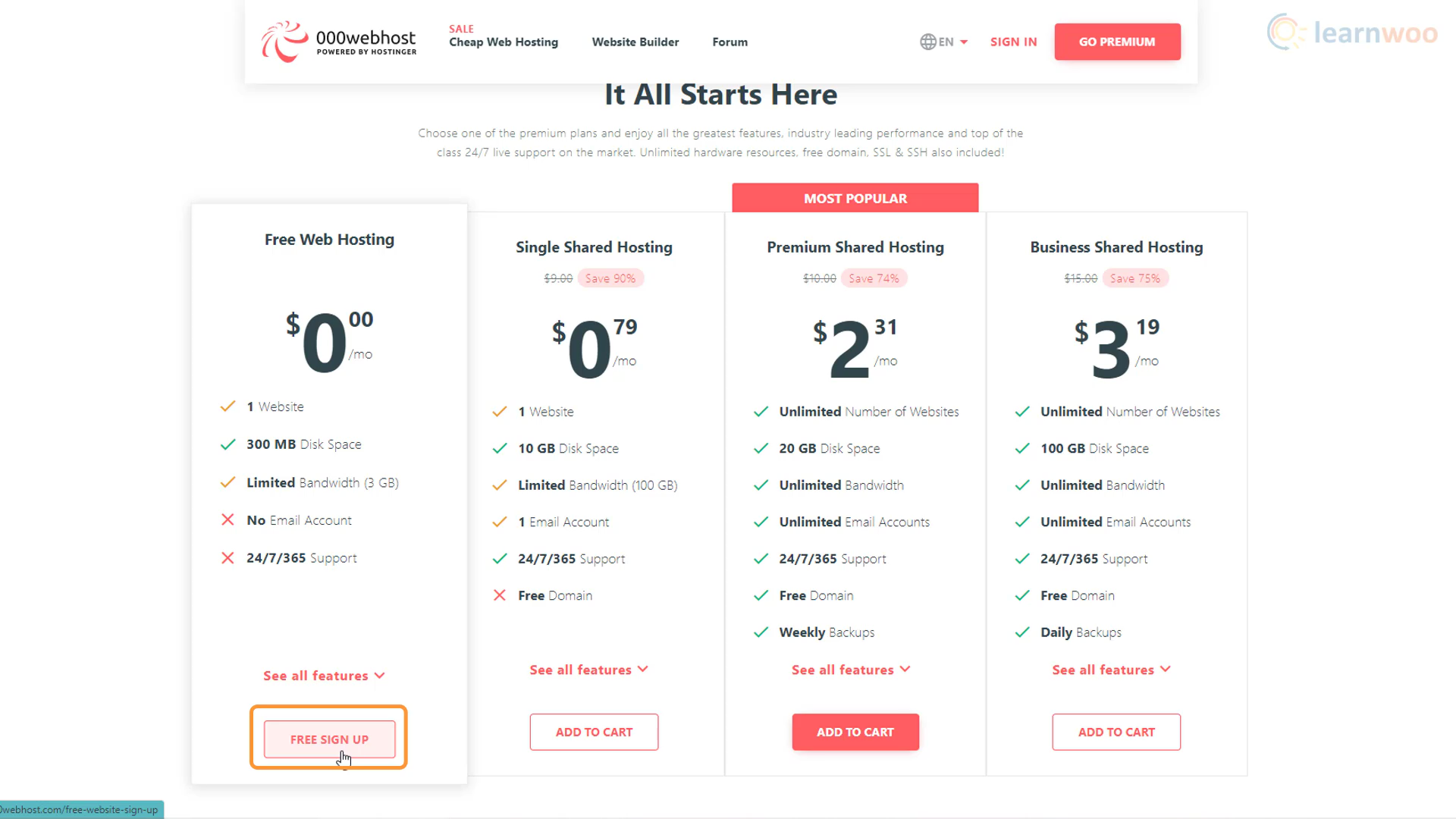

After your email has been verified, a setup wizard will walk you through 5 simple steps:
Step 1: Choose the type of website; whether you want to create a blog, an online store, a web development site, or something else.
Step 2: If you choose a blog, then you’ll have to choose the topics you’re going to write about.
Step 3: 000WebHost will recommend installing the Chrome browser for optimal operation. If you already have it, you can click on Skip.
Step 4: On the next step, you’ll have to name your website and create a password for it.
Step 5: Finally, you need to choose the CMS you’ll be working with. For us, it’s WordPress. When you click on it, a pop up will ask you to create an administrator username and password for your WordPress website. You’ll need these credentials whenever you want to log in to the backend of your website.


After about 60 seconds of loading, your free WordPress website will be live on the internet. You can click on the “Go to Configuration Page” button and use your WordPress credentials to log in to your website.
Importing a Design Template


Your website has been created. But the default version with a sample page and content doesn’t look like much. So let’s start building and designing it. Go to your website’s backend by adding “/wp-admin” at the end of its URL. This is where we control the building blocks of our website like posts, pages, themes, plugins, and settings.


You’ll notice that the dashboard and the website is a bit messy right now. Let’s start cleaning it up. Go to the Plugins tab and click on it. You’ll see that some plugins have been pre-installed by Triple Zero Webhost. To maintain a fast website, it’s important to install only those plugins that are absolutely necessary. The pre-installed plugins are unnecessary, so you can simply delete them. Select all the plugins, choose “Deactivate” from the drop-down, and click on Apply. Finally, select them all again, choose Delete from the drop-down, and click on Apply.


You can now start building a page. Hover over the “Pages” tab in your dashboard and click on “Add new”. This is the WordPress default block builder. You can start by adding a page title. Press the enter button to start a new paragraph and use the plus icon to add other types of blocks like images, headings, galleries, lists, and quotes.
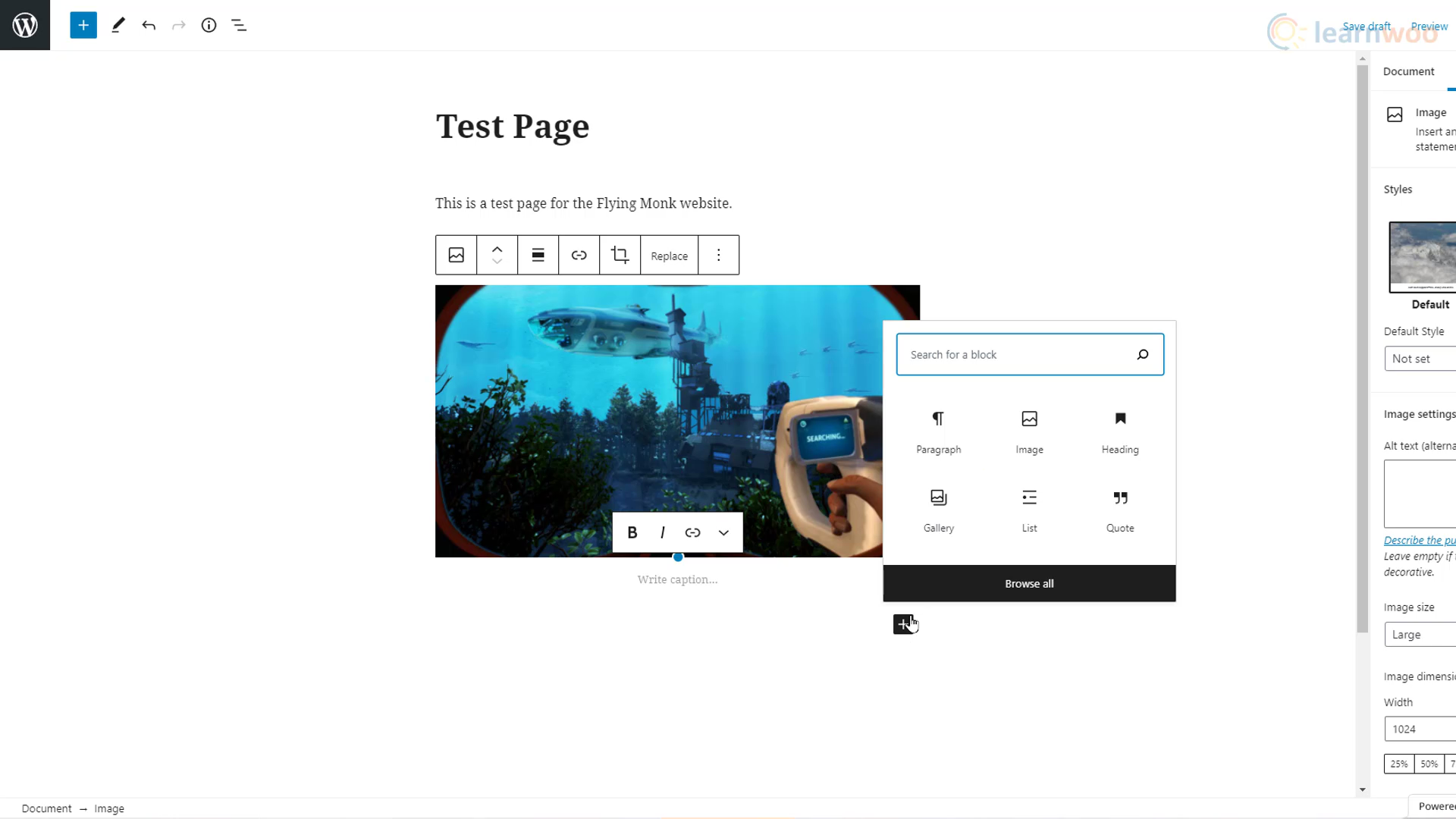

But building every single page and post on our website this way requires a lot of time, effort, and some design knowledge as well. So it’s a much better option to import pre-built templates and edit them according to our needs.
Hover over the “Appearance” tab in your WordPress dashboard and click on “Themes”. Then click on the “Add new” button to add a new theme. Use the search bar to find the Astra theme. Hover over the first search results and click Install. Then Activate it.
To choose a template, click “Get Started” on the next page.
Next, choose Elementor as your page builder as it’s the easiest one to use. In the pop-up, you can browse Elementor’s vast library of templates. Use the filter at the top and select “Free” to narrow down your search. If you like a website template, click on the “Import Complete Site” button at the bottom right. Then click on Import again and wait for the process to complete.
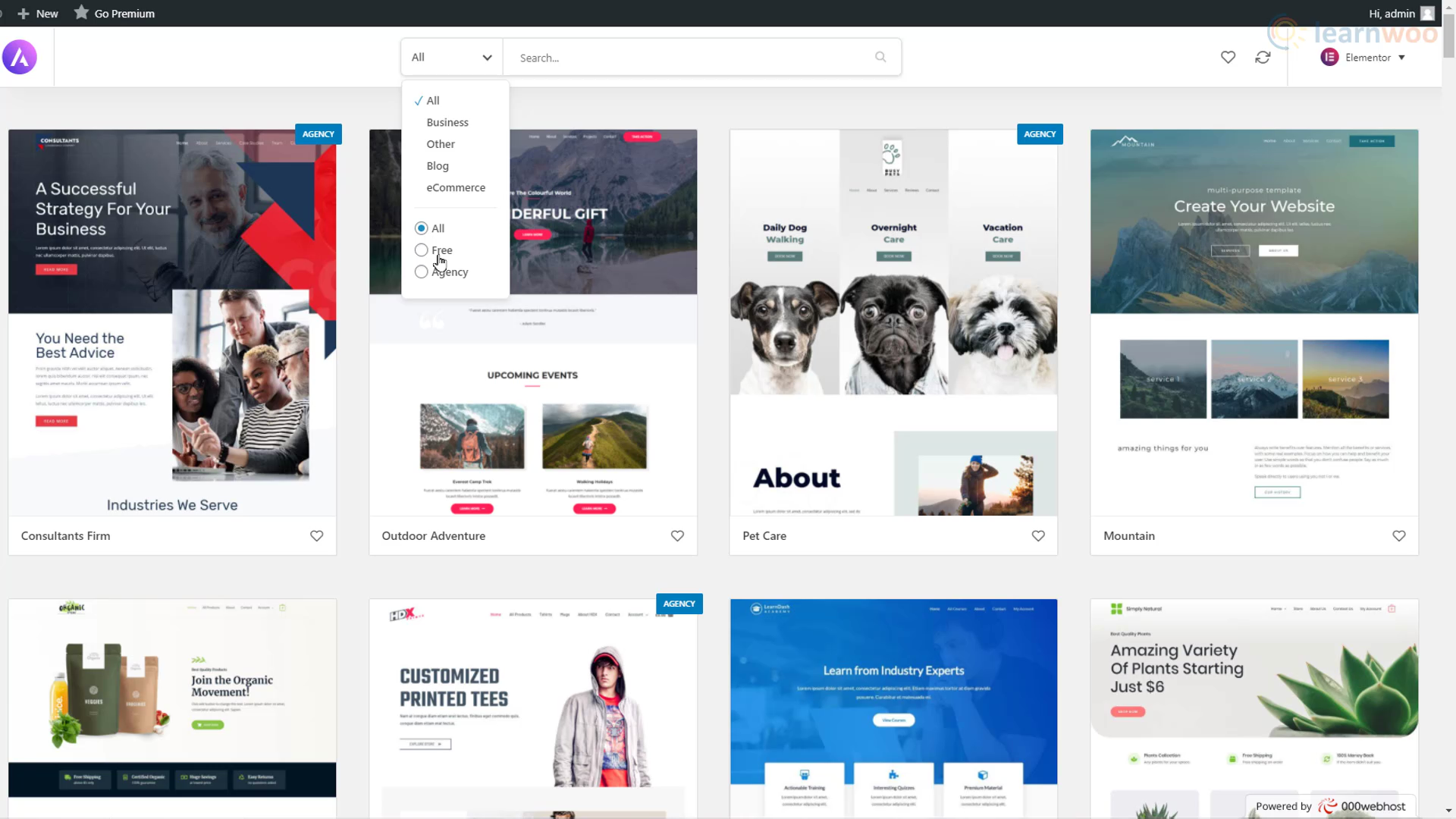

When the import is completed, your free WordPress website will look just like a professional one. It’ll even have the pages and posts with some sample content.


Now, you just need to replace the sample content with your own. Go to any page or post you want to customize and click on the “Edit with Elementor” button at the top.
Elementor lets you build complex web pages with highly customizable drag-and-drop widgets. To edit any text, you can just select it and type your own. You can format the text — change font, size, line height, and more — in the Style section of the editing menu. To replace an image, you can just select it and use the “Choose Image” option in the editing menu.


When you’re done editing the page, you can publish the changes to the live website through the “Update” button at the bottom.
However, you cannot edit the header and footer sections of your website with Elementor. For that, you’ll need to tweak the theme settings using the “Customize” button in the Appearance tab in your WordPress dashboard.
In the customize mode, you can change the site’s logo by clicking on the edit icon next to it. In the Menu section, you can rename, replace, and rearrange the elements in your website’s header. The customization panel also lets you customize your website’s footer, sidebar, and widgets.


When you’re done, click the “Publish” button at the top. Now, when you refresh the website, you’ll see that the changes are reflected on the live site.
Creating and Importing Pages
We now know how to import and edit a website template with existing sample content. But what if we wanted to add a new page. The WordPress+Elementor combination makes this easy too. In your WordPress dashboard, hover over the “Pages” tab and click on “Add new”.
Give your new page a title. Then, click on the “Edit with Elementor” button at the top. From here, there are 3 methods to create a new page.
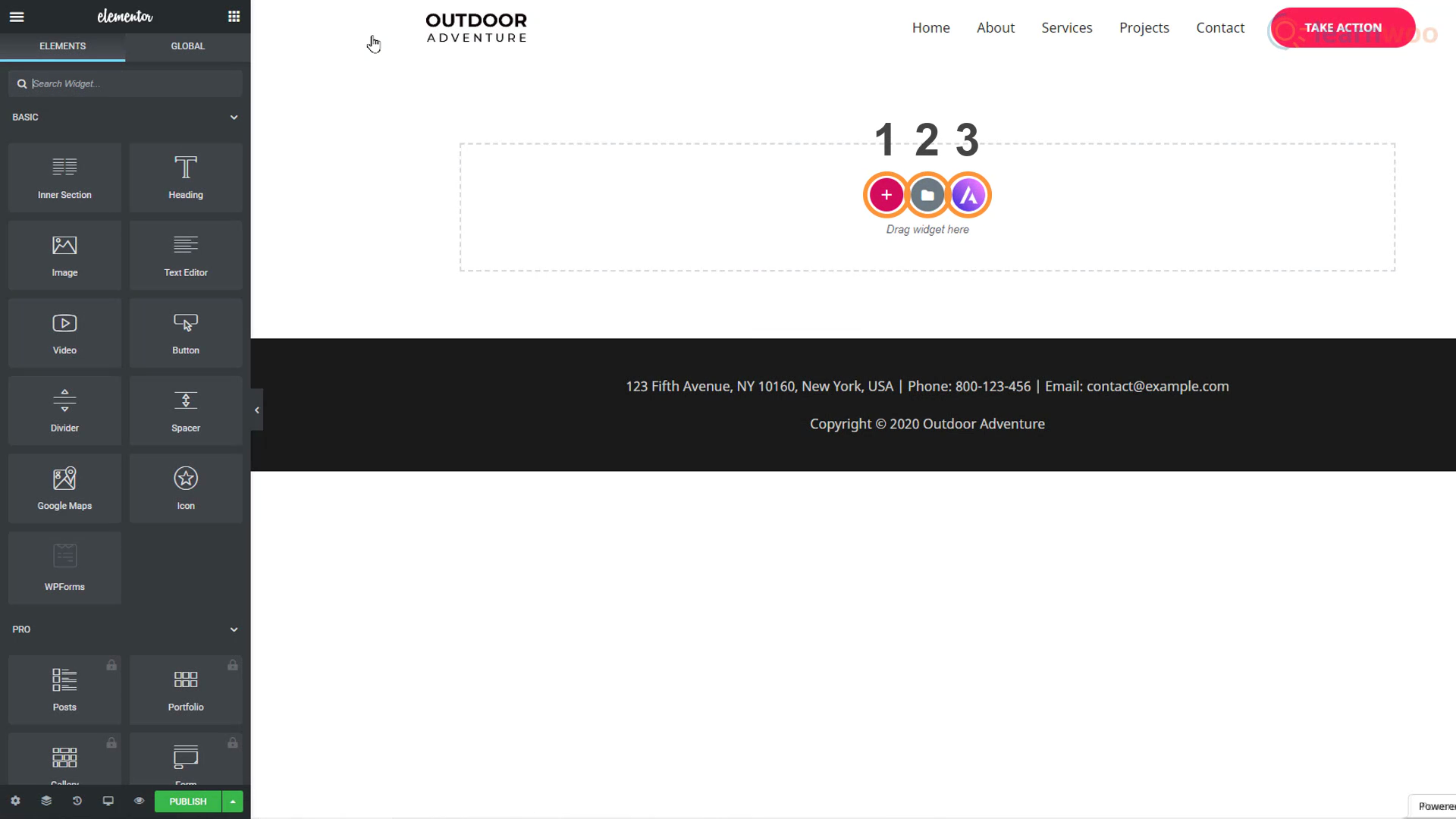

Method 1
You can simply drag and drop the blocks from the editing section on the left. To add a title to your page, just drag the “Heading” block. Then drag the “Text Editor” block to add a paragraph. Images can be added using the “Image” block and you can even control the spacing between elements using the “Spacer” block. In this way, you can build a page block by block from scratch.


Method 2
The second method is to use design templates for pages. You can access a library of page templates designed for various purposes through the folder icon. You can use the search bar to narrow down your results. For example, typing “About” will show all the “About Us” and “About Me” pages in the template library.


Just choose a page template you like and click on the “Insert” button to import the page to your website.
Method 3
We have already chosen an overall design template for our website. But the third method of creating a new page lets us import specific pages from other website design templates. The third Astra-logo icon leads us back to the website design template library.
When we click on a design template, we can access all the individual page templates it comes with. Just click on a page template you like and select “Import Template” at the top. The template will be applied to your blank page.


Click on the “Publish” button at the bottom and refresh your website to see the newly created page.
Moving from a Subdomain to a Domain
You might notice at the top of the browser that your website is a subdomain as it has another phrase between your website’s name and the “.com”. Free hosting providers can only set up a subdomain for you.
And while subdomains are good enough if you’re just starting out or trying something new, your audience may not be able to locate you on the internet just by knowing your name.
A domain not only makes it easier for people to find you, but it also legitimizes your business or brand. If you want a dedicated domain of your own, you’ll have to buy a “.com” domain. However, most hosting providers provide a domain for free along with their paid hosting plans.
There are plenty of cheap yet great hosting options that can take your website to the next level. If you’ve settled on one, the steps from here on out look something like the following:
Step 1: Browse the provider’s paid plans and choose one based on price, web space, bandwidth, and other features.
Step 2: Type the domain name you want for your website. If it doesn’t already exist, you can have it. Some domain extensions may be free, others not.
Step 3: Create an account with the hosting provider with an existing email address and a new password. Also, fill personal information like name, address, and phone number for verification.
Step 4: Select the period of time you want to buy hosting for and pick or unpick from extra services like domain privacy and SEO features.
Step 5: Enter your card information to make the payment.
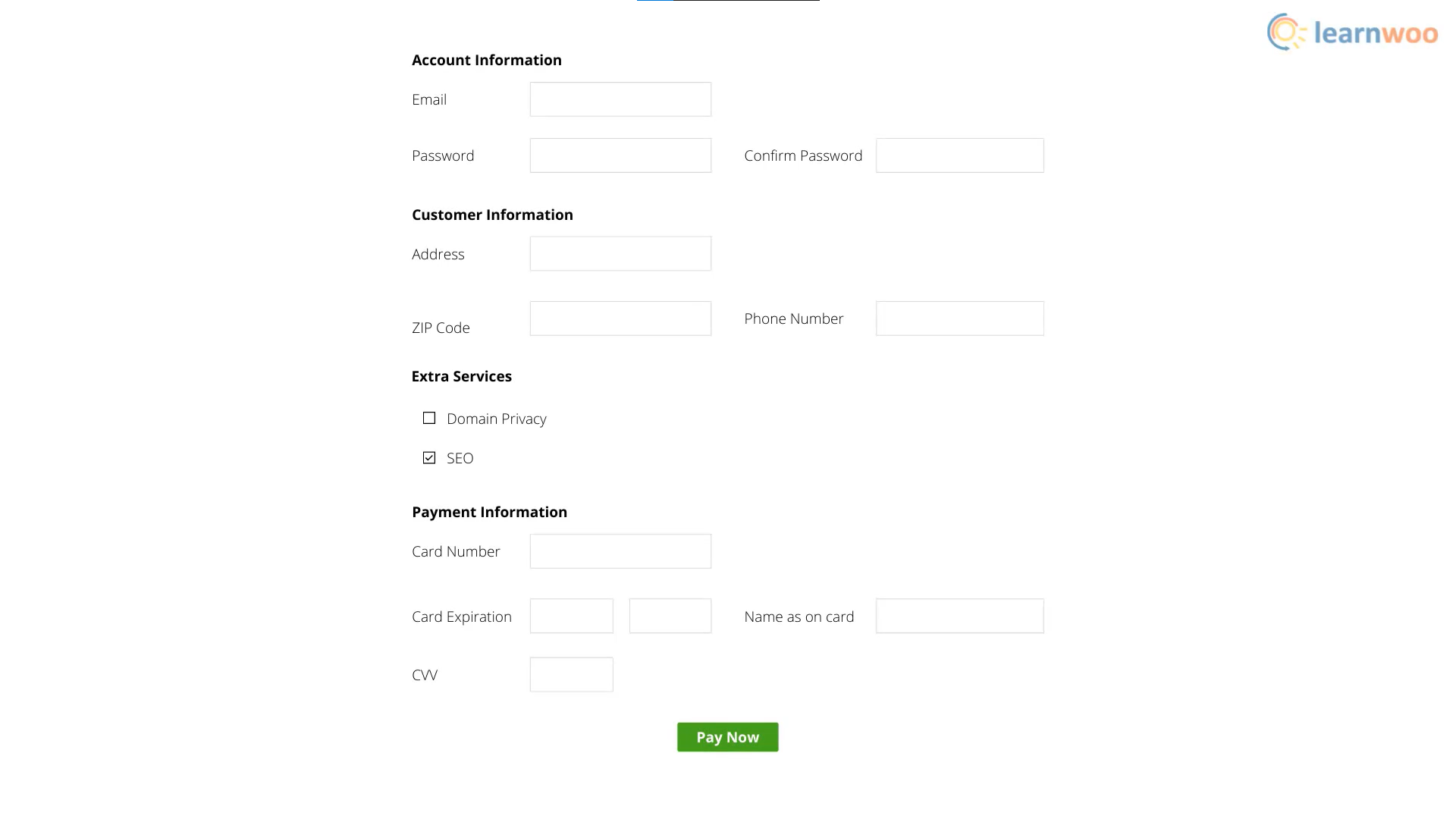

After successfully completing the payment, you’ll get access to the dashboard. Here, you can easily move your website from the free subdomain to the new paid domain.
Stuck somewhere? Reach out to us in the comments and we’ll be happy to help you out.
Check out the video below:












Wow, fantastic weblog structure! How long
have you ever been blogging for? you make blogging look easy.
The total glance of your web site is wonderful, as neatly as the content!
Thanks a lot! The Learnwoo blog has been active since late 2016.